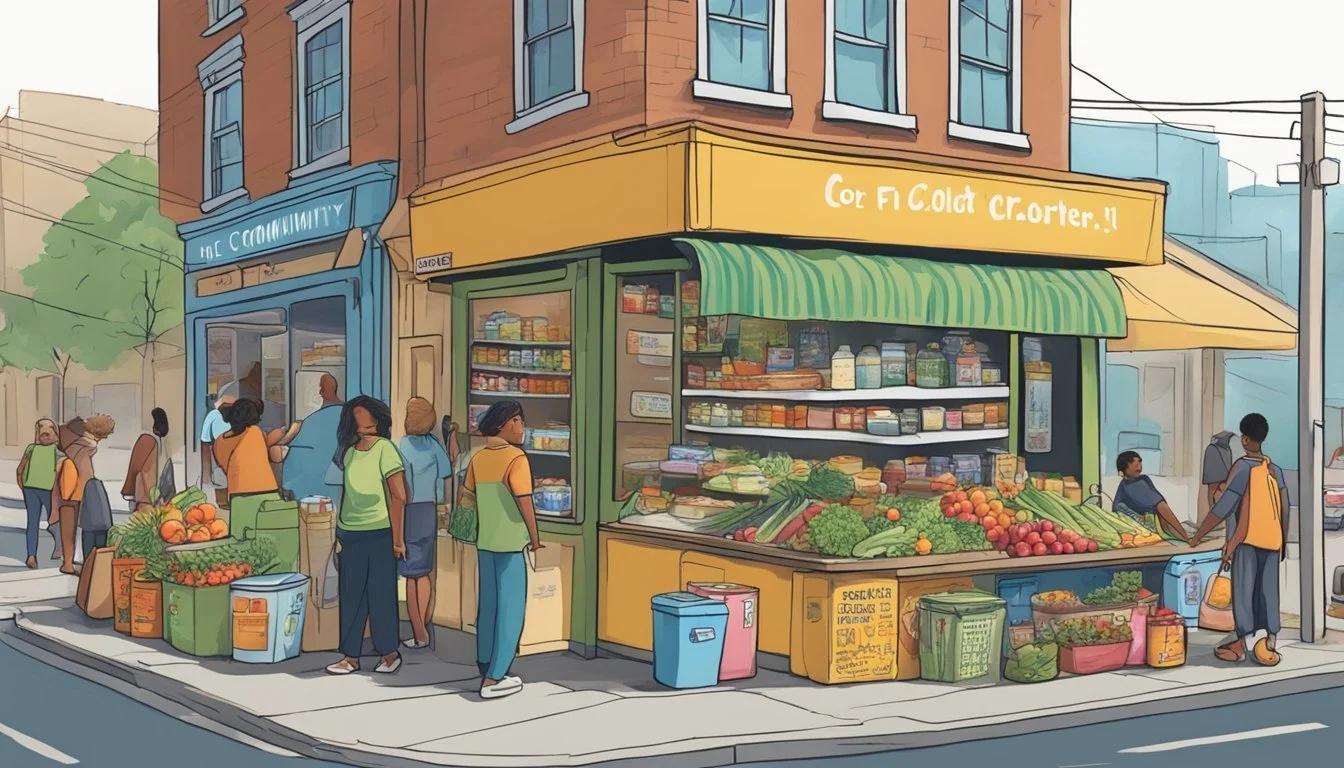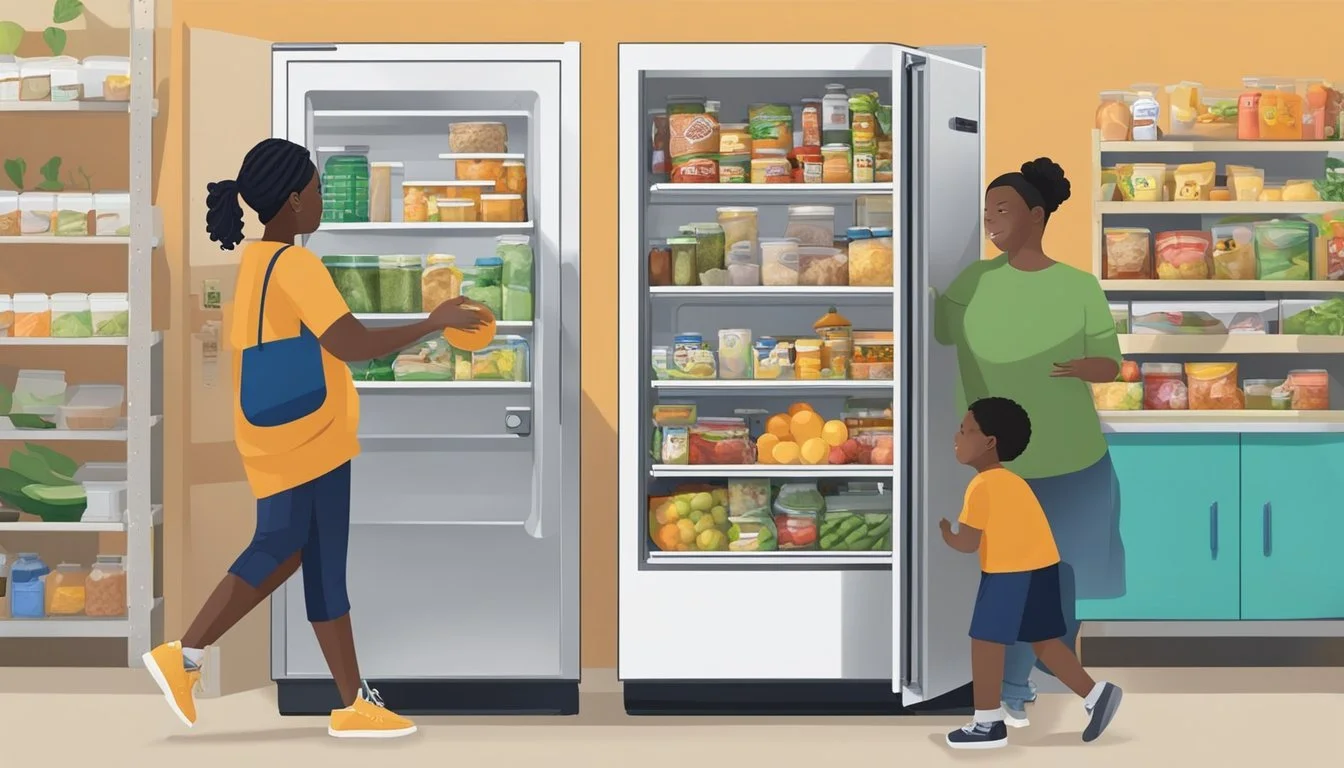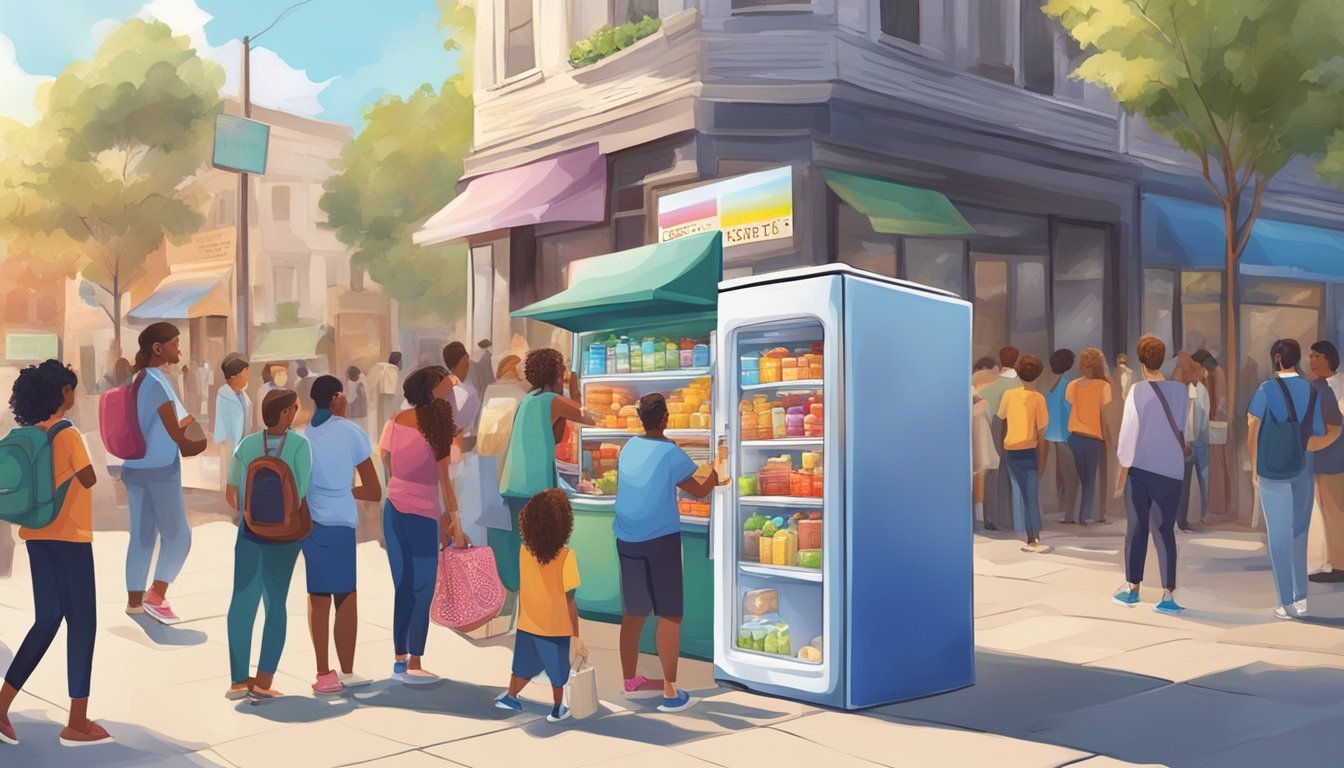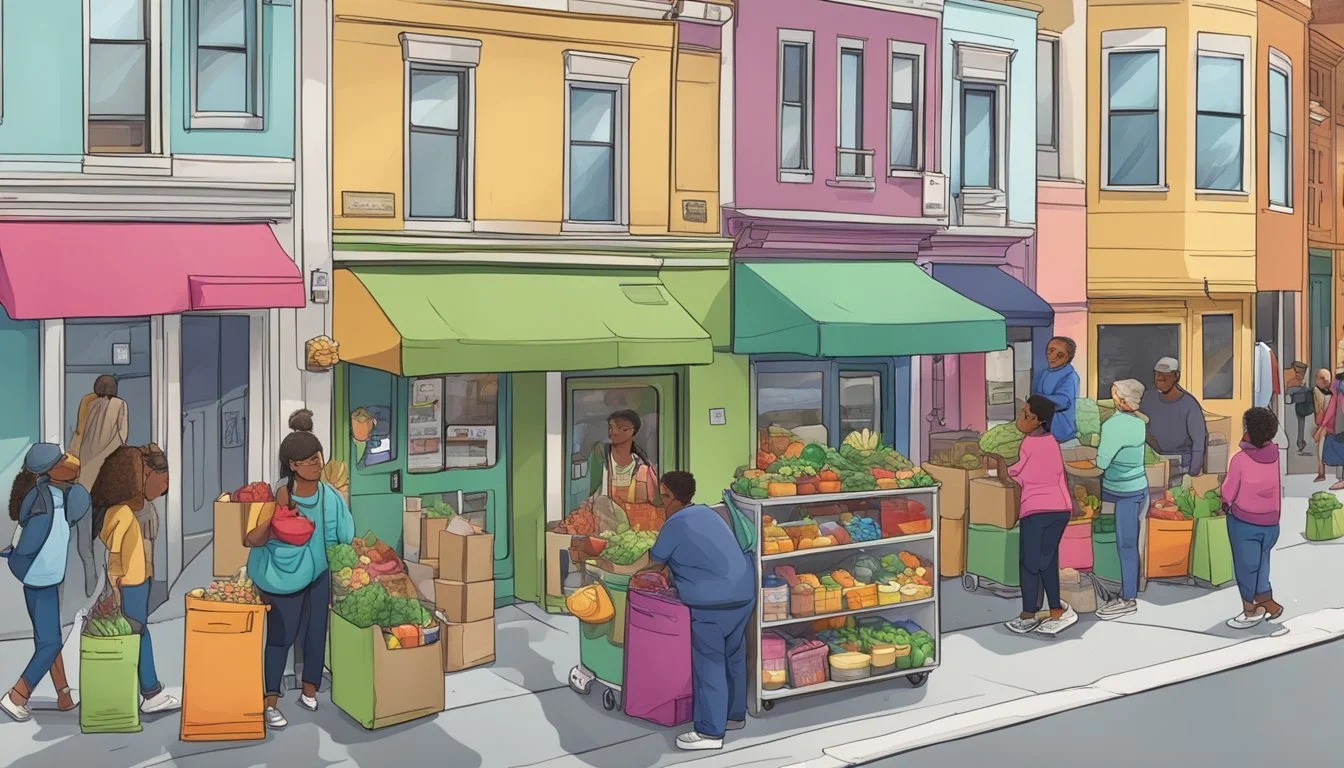South Bend, IN Community Fridge
Addressing Food Insecurity Locally
In South Bend, Indiana, a novel initiative to tackle food insecurity has emerged in the form of a community fridge, locally referred to as a "freedge." This program epitomizes a direct approach to alleviating hunger and promoting food justice in neighborhoods by providing residents with convenient access to nutritious food. Positioned as a symbol of mutual aid, these communal fridges empower individuals to both share and receive fresh foodstuffs, reflecting a grassroots effort to support long-term health within the community.
The concept of the freedge is uncomplicated yet impactful: a refrigerator or freezer placed in a public space where anyone can leave or take food items without any cost or obligation. South Bend's endeavor to combat hunger via such a tangible, community-led solution showcases an innovative step towards addressing a critical social issue. These refrigerators not only serve as a resource for those in immediate need but also play a role in reducing food waste, as they are replenished with edible items that would otherwise be discarded.
This initiative has been made possible through the contributions and cooperation of local organizations, volunteers, and city residents. The freedge in South Bend stands as an inspiring example of how community collaboration can create practical solutions to enhance food accessibility and sustain a network of care among neighbors.
Understanding Community Fridges
Community fridges are a grassroots response to food insecurity and inequity, serving as accessible hubs where individuals may share and access food. They represent a growing effort to ensure equitable food distribution and foster solidarity within communities.
History of Community Fridges
Community fridges, also known as solidarity fridges, originated as a means of offering free food to anyone in need. The movement gained momentum in response to rising food insecurity. The first fridge in the movement aimed to combat both food waste and hunger by making excess food available to the wider community.
Principles of Food Justice
Food justice is central to the community fridge movement, emphasizing everyone's right to fresh, nutritionally adequate, and culturally appropriate food. These fridges operate within frameworks that seek to:
Redistribute surplus food, reducing waste.
Enhance local food systems' sustainability.
Facilitate community self-reliance in addressing food needs.
Impact on Food Insecurity
Community fridges directly address food insecurity by providing a stigma-free, anonymous way for individuals to obtain food. Through local support and donations, they can help alleviate the uncertainty some individuals face in acquiring enough food.
They improve food accessibility, especially in areas where grocery stores are scarce.
The fridges supplement food supplies for a variety of community members, from those facing temporary hardships to long-term need.
For a city like South Bend, IN, the introduction and support of community fridges would be a significant step toward local food sustainability and social equity.
The Start of South Bend Community Fridge
The inception of the South Bend Community Fridge marks a significant move in the city's efforts to address food insecurity. It embodies the community's resolve to ensure accessible, healthy food options for those in need.
Need for a Community Fridge in South Bend
In South Bend, the need for food assistance has been a pressing issue. With pockets of the population facing challenges in obtaining nutritious meals, the idea for a community-sustained solution came to light. A community fridge serves as a hub where individuals can access fresh food, free of charge, thus directly mitigating the problem of food scarcity for many families.
Establishing the First Fridge
The establishment of the first community fridge in South Bend was a grassroots effort, reflecting the community's dedication to supporting its most vulnerable members. This inaugural refrigerator was designed to be more than just a temporary fix; it was conceived as a starting point for a broader movement aimed at fostering communal support and shared responsibility in addressing food accessibility.
Location: Near Northwest Neighborhood, Inc.
Name: Feed a Friend, South Bend
Launch: Initiated with support from local organizations
The Role of Freedge Organization
The Freedge organization played a pivotal role by providing a framework for South Bend's endeavors in launching the community fridge program. Freedge's involvement ensured that the community fridge was not only a place for food but also a symbol of shared community resources and resilience.
Impact: Empowers communities to fight food insecurity
Contribution: Offers guidance and support for setting up freedges
Operation and Management
The success of the South Bend Community Fridge hinges on robust volunteer coordination, clear donation guidelines, and strict adherence to food safety and maintenance protocols. These operational pillars ensure the fridge provides a reliable and safe source of food to those in need.
Volunteer Coordination
Volunteers are fundamental to the community fridge’s operation. They oversee the sorting, stocking, and cleaning of the space. A schedule is typically managed to ensure that there are always enough volunteers to maintain the fridge:
Stocking: Assigning individuals to monitor and replenish the fridge.
Cleaning: Regular cleaning shifts to maintain hygiene standards.
Each role is critical, and coordination is often facilitated through online sign-ups or local community boards.
Donation Guidelines
Donating food to the community fridge is guided by a set of rules to ensure that only safe and appropriate items are available. General guidelines include:
Acceptable Items: Fresh fruits, vegetables, packaged foods with a clear expiration date.
Prohibited Items: Opened packages, homemade meals, alcohol, or expired products.
Clearly posted signs and online posts often communicate these guidelines to potential donors.
Food Safety and Maintenance
Adhering to food safety regulations is paramount. The fridge is regularly checked for:
Temperature: Ensuring the fridge stays at a safe temperature to prevent bacterial growth.
Expiration Dates: Routine inspections to remove out-of-date items.
Maintenance involves:
Repairs: Promptly addressing any technical issues with the fridge or related facilities.
Cleaning: Both scheduled cleaning and spot checks to maintain a hygienic environment.
Overall, through vigilant operation and management, the South Bend Community Fridge aims to be a sustainable, safe, and welcoming resource for all community members to access food.
Locations and Accessibility
In South Bend, the concept of community fridges aims to address food insecurity through easily accessible sources of nourishment. The establishment of these refrigerators in key neighborhoods indicates a targeted approach to reach individuals experiencing hunger.
Near Northwest Neighborhood Station
The Near Northwest Neighborhood is home to a community fridge, colloquially known as a "freedge." It is strategically positioned here to serve residents, ensuring those in immediate need have access to fresh food. The location operates with a simple premise: take what you need, leave what you can.
Address: [Exact Address]
Hours of Operation: 24/7
Food Type: Fresh produce, protein, non-perishables
Accessibility: Wheelchair accessible, no ID or verification required
Map Coordinates: [There could be a link or embedded map here]
Expansion to Other Neighborhoods
Efforts are ongoing to expand the "freedge" initiative to other areas within South Bend. These new locations will be selected based on community needs and the potential for positive impact. Each station will mirror the Near Northwest Neighborhood's commitment to open access and 24/7 availability.
Planned Locations: [List of Neighborhoods]
Projected Opening Dates: [Table or List of Dates]
Community Involvement: Strong influencer in deciding new locations
Support Opportunities: Donations/volunteering information
New Sites Map: [Map showing future locations and current areas served]
Supporting and Expanding the Movement
The Community Fridge movement in South Bend demonstrates effective ways to combat food insecurity. One can participate in a variety of roles: starting a fridge, joining the cause, or collaborating with local entities.
How to Join the Cause
Individuals looking to contribute to the community fridge movement can do so by directly supporting existing fridges through donations of food, time, or funds. They can volunteer for shifts to clean and stock the fridge or assist in fundraising efforts to maintain and expand operations.
Resources for Starting a Fridge
For those interested in initiating their own community fridge, a myriad of resources are available:
Guides: Step-by-step manuals on how to launch and sustain a community fridge.
Legal Advice: Counsel regarding permits and food safety regulations is crucial.
Templates: Documents for planning, volunteer coordination, and community outreach.
Collaborating with Local Businesses and Organizations
Building partnerships is vital for the movement's growth. Local businesses can offer surplus food, while organizations can provide a network of support and logistics.
Partnership Models:
Donation Agreements: Contracts with businesses for regular food contributions.
Sponsorships: Financial or material support from local enterprises.
Community Engagement:
Education Sessions: Workshops hosted by organizations to inform the community about the cause.
Volunteer Drives: Initiatives to recruit volunteers and amplify reach through organizational channels.
Community Involvement and Impact
South Bend's Community Fridge initiative exemplifies how collective action and shared responsibility foster a supportive environment. This section delves into the experiences of those at the forefront, the poignant narratives of beneficiaries, and the creative collaborations that magnify the project's outreach.
Volunteer Experiences
Volunteers are the cornerstone of the Community Fridge program, dedicating time and effort to ensure its robust operation. They help organize food donations and maintain the fridges, ensuring a hygienic and welcoming space for all who access them. From stocking shelves to cleaning, their stories are ones of personal growth and communal contribution.
Example of a volunteer's schedule:
Weekday Mornings: Inventory check and restocking
Weekday Afternoons: General cleaning and organization
Weekend Events: Community outreach and educational activities
Community Stories
The impact of the Community Fridge can best be felt through the stories of community members who rely on this resource. Individuals and families share how access to fresh, healthy food has alleviated the stress of food insecurity. It's not only about nourishment but also the sense of community that grows when residents engage with the service.
Impact on Families:
Provision: Reliable access to food for children and adults alike.
Unity: Strengthened communal bonds through shared experiences.
Partnerships with Local Art and Education
Collaborations with local art groups and educational institutions enhance the visibility and reach of the Community Fridge. Artistic contributions beautify the spaces, attracting attention and encouraging care of the fridges. Educational workshops, often led by volunteers and group members, engage children and adults alike in food-related topics, promoting better nutrition and food sustainability.
Engagements:
Local Artists: Fridge murals and public art projects.
Educational Programs: Workshops on nutrition, food waste, and sustainability.
Challenges and Solutions
In the realm of community fridges, such as those found in South Bend, IN, organizers face a series of challenges from minimizing food waste to maintaining a supply of diverse food items and securing the necessary funding and community backing. Strategies are in place to confront these issues effectively.
Combating Food Waste
Community fridges in South Bend, Indiana, tackle food waste directly by offering a space for surplus food distribution. To ensure the food remains suitable for consumption, rigorous monitoring systems are in place. Schedules for regular checks and updates on the status of food items help in reducing the disposal of spoilt goods, thereby limiting waste.
Handling Perishable and Dry Goods
The community fridge initiative strives to balance the stock of perishable items with dry goods. Refrigeration keeps fruits, vegetables, and proteins fresh, while shelving for dry goods ensures a well-rounded selection of food options. This system also prevents the overcrowding of perishable items, which can lead to quicker spoilage and waste.
Securing Funds and Support
The sustainability of community fridges depends heavily on continuous funding and community support. Securing grants is a primary method for obtaining finances, but the drive does not end there. Community involvement is key, with locals contributing not just through monetary donations but also by volunteering and keeping the fridges stocked and clean.









